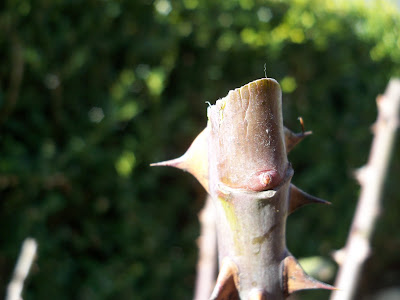
Last week I started pruning roses in my backyard. The ones in the front of the house still need to be pruned but since they are mostly climbing roses, pruning is not so critical at this point.
Why prune roses?
As opposed to traditional beliefs, roses are very hardy and forgiving plants. There are hundreds of rules everywhere on how to prune roses. For the last fourteen years that I've tended roses in my own garden, this is the one key lesson I've learned about pruning: The height and angle of the cut, the direction of the bud next to the cut, and even time of pruning does not really matter in the overall growth and performance of the rose.
Therefore, instead of describing a standard procedure here, I am going to explain the reasons for pruning. Anybody who understands these reasons will eventually learn how to prune.
1. To increase plant vigor. Unproductive canes are dependent on the healthy ones for their maintenance. Removal of the diseased, small and old (brown instead of green) canes will result in a healthier plant. Not only will the plant look cleaner but it will also have less chance of infection from the same diseases that infected the previous years' growth.
2. To increase and prolong flowering period. Pruning encourages the growth new canes. Younger canes tend to have a vigorous growth resulting in more branching. Since flowers appear on new branches, more flowers will be produced. Eventual pruning, also known as dead-heading, will have the same effect of encouraging further flowering.
3. To train the rose to desired shape and direction. Roses are planted for different purposes. Some are grown as accent plant, climber, ramblers, or in beds as in botanical gardens. In general, roses are pruned to have an open vase-shape allowing the canes to grow slightly outward as in the letter V.
Ramblers and climbers are pruned to train and guide the canes to follow a specific direction as is growing to cover an arbor. Once they are established, pruning will be done to maintain the shape and remove dead and damaged branches. New canes will grow and if they are not wanted, be ruthless to cut them off. Some climbers, such as 'Cecile Brunner', are very aggressive that if you allow them to grow without intervention, then you are setting yourself for a mega-pruning job in the future.
General Pruning Tips:
1. Equip yourself with very sharp pair of shears. They will make life easy for you and your roses.
2. Protect yourself with heavy duty gloves to avoid unnecessary cuts and scratches.
3. Choose the canes that you want to remain. Consider vigor, position, and age of cane.
4. Remove all unwanted canes and dead wood.
5. Cut the remaining canes to desired height. For taller roses, prune higher and vice versa.
6. Remove all old leaves from pruned plants. This will trick the plant into believing that it has gone through dormancy and now it should start to grow.
Stroll in your garden, it's good for you and your plants.
4 comments:
Hello again! Just checking out your rose post. I just bought a white rose myself. And this early, I'm already tempted to prune it. It's so much fun to prune. I think I got too used to herbs.
This is very informative content. Nice and very unique content. I appreciate this. Thank you so much for this information. I hoped you like my compliment. Medium Weight Tarpaulin
Your eloquent prose dances effortlessly across the page, leaving a trail of inspiration in its wake. Thank you for gracing us with your literary brilliance. lightweight tarpaulins
your blogs are outstanding class i love it.
white tarpaulin
Post a Comment